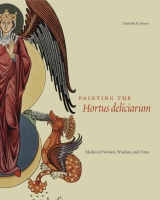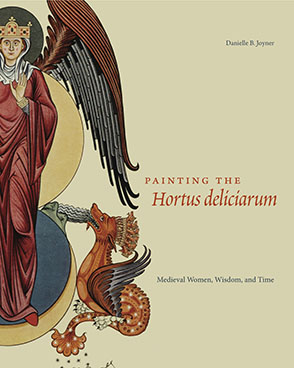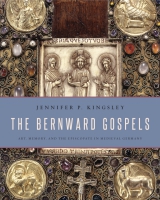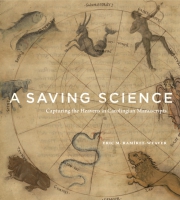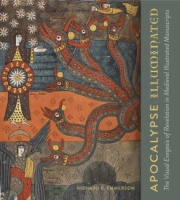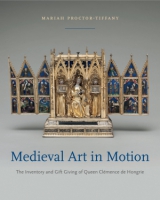Painting the Hortus deliciarum
Medieval Women, Wisdom, and Time
Danielle B. Joyner
“Danielle B. Joyner presents her analysis in a concise, fluid writing style and she has selected magnificent images from the HD to accompany her insightful text. Painting the Hortus Deliciarum is a welcome addition to any medieval collection.”
- Description
- Reviews
- Bio
- Table of Contents
- Subjects
In this close study of the art and history of the Hortus deliciarum, Danielle Joyner shows how the book reflected twelfth-century concerns, such as emphasizing a historical interpretation of the Bible and reconciling scientific and theological accounts of the cosmos. She analyzes the images, texts, ideas, and processes at work in the manuscript and offers insights into how it configured a history of the Church in the temporal world as a guide to achieving eternal salvation.
By tracing the flexibility and efficacy of the multiple visions employed in the manuscript, Joyner explores how the Hortus deliciarum crafted a deeper understanding of the integral role of time in medieval constructions of history, the cosmos, and humanity’s place within them. Scholars and students of art history, medieval and early modern studies, religion, gender, and the history of the book will find Joyner’s work especially valuable, compelling, and provoking.
“Danielle B. Joyner presents her analysis in a concise, fluid writing style and she has selected magnificent images from the HD to accompany her insightful text. Painting the Hortus Deliciarum is a welcome addition to any medieval collection.”
“In order to identify what is distinctive about the Hortus, the author looks at the textual sources used, the twelfth-century monastic context, and comparable compendia with shared concepts. Also of interest to students of the history of science, the book pays serious attention to cosmological diagrams and computus tables for tabulating the dates of movable feasts, arguing that these tables are themselves a form of exegesis and essential elements in the overall educational message of the work and its biblical history and concern with moral struggle against vice. . . . Written in an engaging and accessible style, the book is copiously illustrated and well documented, and it has a lengthy bibliography.”
“Even in the post-Enlightenment academic world these emphatically medieval Christian works continue to nourish intellectual growth.”
“Joyner’s book will be valuable to any scholar interested in the intellectual life of medieval monastic women’s communities. It bolsters previous studies that have shown the level of sophisticated learning that was available at Hohenbourg, and thus furthers the case that medieval women’s education could be more complex than currently thought.”
“Though Joyner is an art historian and her study is primarily of the HD’s images, one of its real strengths is her fresh appreciation for and approach to the texts whose ideas shaped the manuscript’s sensibilities. Rather than relying simply on modern studies of twelfth-century thought, she reads the original texts in some of the same ways that Abbess Herrad must have, following medieval cues in order to situate the manuscript within the Hohenbourg’s wider intellectual life.”
“Painting the Hortus deliciarum reassesses the visual mechanics of the HD, expands our understanding of twelfth-century women's education, and rethinks the structure and dynamics of time as it was understood in the middle ages.”
“Painting the ‘Hortus deliciarum’ breaks new ground by addressing the central role of time—historical, cosmological, exegetical, and liturgical—in Herrad's vision. Joyner brings to her art-historical analysis an exceptional grasp of both the intricate technicalities and the rich moral, ascetic, and theological resonances of time and time-reckoning for the Middle Ages. Her portrait of Herrad reveals a creative ‘visual theologian’ who is also deeply rooted in the learned traditions of her age.”
“Expanding positivist scholarship, Danielle Joyner considers the Hortus deliciarum’s function and the intellectual currents that generated its illustrations. Sensitive to slippages in the copying of pictorial, scientific, and textual sources, she argues that Herrad not only compiled an encyclopedia of traditional knowledge but also taught her community ways to seek new information from it and to formulate original ideas.”
“Painting the ‘Hortus deliciarum’ is an erudite, probing exploration of the sophisticated ways in which monastic authors and artists took up the challenge of visualizing a plural conception of time in the high Middle Ages. In Joyner's lucid and compelling account, we rediscover the important role played by images for female monastics' understandings of the rich interplay between calendar and cosmos. Sensitive to the imbrication of tradition and innovation in the images she treats, Joyner gives us an important new perspective into the vision of ‘divine wisdom at work in the world’ cultivated by women religious in the Middle Ages”
“Joyner has made a solid contribution to the study of twelfth-century monastic literature and to the study of the Hortus Deliciarum in particular. Her volume, beautifully illustrated and extensively documented, should find a place in academic libraries and, it is hoped, will provide a useful springboard for future study of this rich and enigmatic masterpiece.”
Danielle Joyner is Assistant Professor of Medieval Art History at Lawrence University.
List of Illustrations
Acknowledgments
introduction:
The Garden of Delights
1 Feminae, Libri, et “Hortus deliciarum”
2 Stellae et Tempora
3 Artes et Computus
4 Horae, Elementa, et Sapientia
5 Ecclesia et Historia
conclusion
Notes
Bibliography
Index
Mailing List
Subscribe to our mailing list and be notified about new titles, journals and catalogs.
